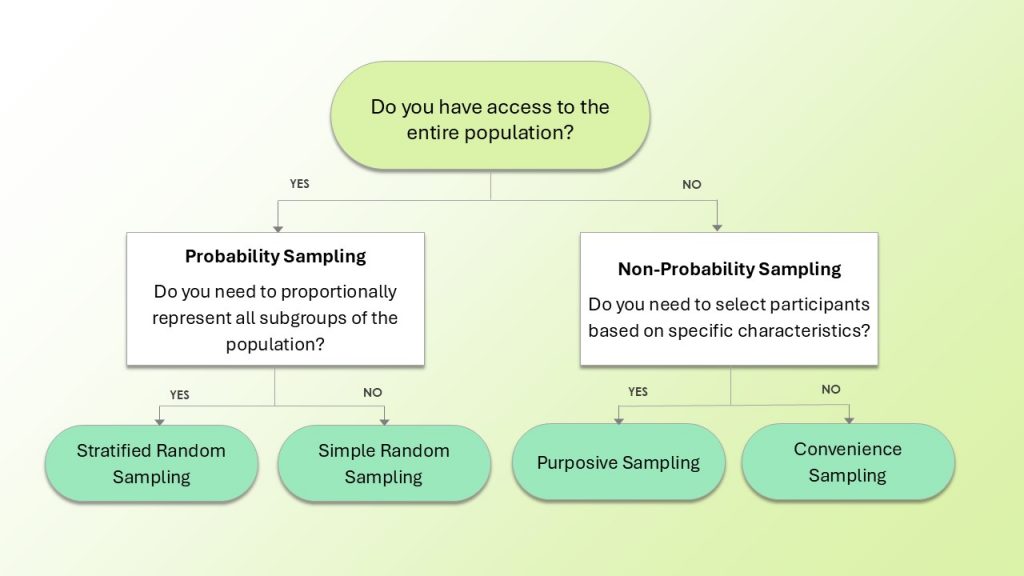Methodology | Quantitative vs Qualitative | Sampling | Data Collection | Data Analysis
Sampling is the backbone of effective research. Whether conducting a scientific study, a market analysis, or a social experiment, choosing the optimal sampling method can make or break your results. In this blog, we’ll demystify sampling, exploring probability-based and non-probability-based methods and how to select the right approach. We will define sampling error and how it can impact your results. Dive in to master the art of sampling and elevate the accuracy and reliability of your research!
1. Probability-based sampling methods
Probability-based sampling methods are the gold standard for ensuring every individual in a population has an equal chance of being selected. This makes your results scientifically robust and unbiased. By leveraging randomization, these methods provide the foundation for accurate, reliable, and generalizable research findings.
|
Probability-Based |
Description |
|---|---|
|
🎲 Simple Random Sampling |
Each participant has an equal chance of being selected. Using a random number generator to draw numbers. |
|
📏 Systematic Sampling |
Data is selected in fixed periodic intervals. |
|
🧩 Stratified Random Sampling |
Choosing a random number of items from subgroups so that different subgroups are equally represented. |
|
📦 Cluster Sampling |
Partition the population into clusters and then sample the cluster (practical, cheap, and good for a homogenous population). |
Let’s examine specific research studies and understand why a particular probability sampling technique is best suited for them!
|
Research Questions |
Optimal Sampling and Why? |
|---|---|
|
❓ A university wants to study the satisfaction levels of its 10,000 students regarding campus facilities. |
🎲 Simple Random Sampling |
|
❓ A retail chain wants to evaluate customer feedback from 5,000 receipts generated in a single day. |
📏 Systematic Sampling |
|
❓ A public health organization wants to study vaccination rates among different age groups in a city. |
🧩 Stratified Random Sampling |
|
❓ A national education agency wants to assess the academic performance of 5th-grade students nationwide. |
📦 Cluster Sampling |
Tip: Note that these studies all use very large sample sizes! Probability Sampling methods are best for selecting large sample sizes and when you want the results to be generalizable
2. Non-Probability based sampling methods
Non-probability sampling methods offer a practical alternative when randomness isn’t feasible. They rely on the researcher’s judgment or convenience to select participants. While these methods may not guarantee generalizability, they excel in providing quick insights and exploring niche or hard-to-reach populations.
|
Non-Probability Based |
Description |
|---|---|
|
🛒 Convenience Sampling |
Based on availability or accessibility, particularly when the researcher has few resources, the sample may not be representative and introduce bias. |
|
🎯 Purposive Sampling |
Getting data from hard-to-find or rare populations is prone to research bias. |
|
❄️ Snowball Sampling |
By referral, current study subjects recruit additional subjects. |
Let’s examine specific research studies and understand why a non-probability sampling method best suits the study!
|
Research Questions |
Optimal Sampling and Why? |
|---|---|
|
❓ A college wants to assess the effectiveness of a new online learning platform by surveying students attending its computer lab. |
🛒 Convenience Sampling |
|
❓ To improve treatment protocols, a healthcare researcher investigates patients’ experiences with a rare genetic disorder. |
🎯 Purposive Sampling |
|
❓ A sociologist studies the experiences of undocumented immigrants in accessing healthcare services. |
❄️ Snowball Sampling |
Tip: Note that these studies all use small sample sizes! Non-probability sampling methods are best for selecting small sample sizes of people with specific characteristics. The results are usually not generalizable to a broader group.
3. How to select a sampling method?
Choosing the correct sampling method is like laying the foundation for a successful research study—it determines your results’ accuracy, reliability, and relevance. But with so many options, how do you decide which method is best? In this section, we’ll guide you through key factors to consider, from your research goals to resource constraints, helping you make an informed choice that aligns with your study’s needs. Let’s simplify decision-making and set you on the path to meaningful insights!
|
Probabilistic Sampling |
Non-Probabilistic Sampling |
|---|---|
|
✔ I want to generalize my results. ✔ I need a large sample size. ✔ My analysis will be quantitative. ✖ Time and resource-intensive, especially for large and/or geographically dispersed populations. |
✔ I want deep insights into something. ✔ Participants are scarce. ✔ My analysis will be qualitative. ✖ Non-probabilistic sampling risks bias and lacks generalizability, as participants are not selected randomly. |
Remember, the choice between probabilistic and non-probabilistic sampling hinges on your research goals. If generalization is necessary, probabilistic methods are ideal despite their complexity. For niche or exploratory studies, non-probabilistic methods provide targeted insights but limit external validity. Researchers must weigh these trade-offs to align their sampling approach with the study’s objectives and constraints.
You can create a decision tree to help make your decision. Here is a simplistic example. Your specific questions and branches will be based on your research goals and population characteristics.

4. What is a sampling error?
A sampling error occurs when the sample selected for a study does not accurately represent the entire population. This leads to differences between the sample’s results and population parameters. Sampling errors can arise from sample size, selection bias, or randomness in choosing participants. For example, a survey that unintentionally excludes certain demographic groups may yield inaccurate results. While sampling error is inevitable in most research, it can be minimized using larger, well-constructed samples and probabilistic sampling methods to represent the population better.
A Real-life example of sampling error
✖ A large bakery chain conducted a survey to decide which new dessert to add to its menu. Since they needed to save time, they only surveyed customers at two high-end urban locations out of fifteen locations. The survey results overwhelmingly favored a gourmet chocolate mousse. The bakery rolled out the mousse in all its locations and discovered that its rural and suburban customers preferred a simple apple pie and did not purchase it.
_ Sampling error
✔ The bakery owners needed to take the extra time to survey a subset of customers in urban, suburban, and rural locations. Although it would have taken more time, the bakery would have avoided the cost of offering a product that did not sell and that did not satisfy a majority of their customers.
_ Sampling error mitigation
5. Summary
This blog provided a comprehensive guide to sampling methods, demystifying their complexities for researchers. It explained probability-based methods (e.g., simple random, stratified, cluster) and non-probability methods (e.g., convenience, purposive, snowball) with practical examples demonstrating their applications. You learned how to select the optimal sampling method based on research goals, constraints, and trade-offs, and the blog addresses common challenges like sampling errors. With its clear explanations and actionable insights, this blog equips you to make informed decisions and improve the accuracy and reliability of your research.






